MARIANI’SVirtual Gourmet
June 3,
20012
NEWSLETTER
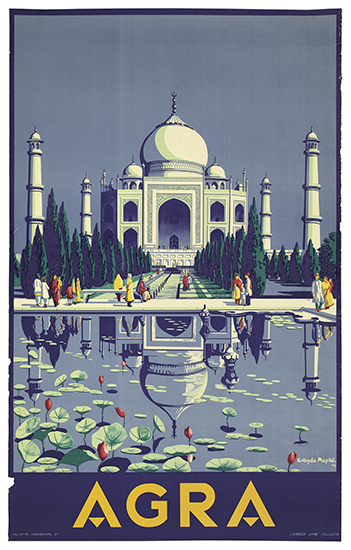
Indian Travel Poster by Gobinda Manda
❖❖❖
THIS WEEK
by John Mariani
NEW YORK CORNER
PALM:
THE
ONLY STEAK
YOU’LL EVER NEED
by
John Mariani
The Wines of Galicia
by David Lincoln Ross
❖❖❖
Summer
Reading List
by John Mariani
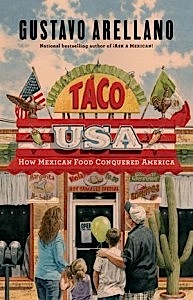
Taco USA
by Gustavo Arellano ($25)--Gustavo
Aurellano is America's leading authority on Mexican
and Mexican-American culture, and this book, which
includes many of his columns from the OC Weekly where
he is editor and author of the "Ask a Mexican"
column, tells you everything you might have wondered
about a food once called "Spanish" became an ethnic
American genre. The histories of everything from
Taco Bell to Chipotle Grill, Diana Kennedy to Rick
Bayless, and so many others who have created a
cuisine about which Americans are ravenous, is all
here. Written with style, scholarship and wit, this
is a good read that will teach you a lot.
Sausage by Nicola Fletcher and Caroline Bretherton ($22)--Who knew? Australia makes a sausage named Cheerios; Koreans make Sundae; South Africa makes Chakalaka. But then, Americans make hot dogs. All this, and a lot of good recipes, are included in this splendid photographic study of the dizzying world of casings stuffed with everything imaginable. The explanation of terms like PDO, PGI and TSG are clear, as well as the difference between salami and salame. With 300 examples of sausages, this is definitely the only book you'll need on the subject for a long time.
The James Beard Foundation's Best of the Best by Kit Wohl ($60)--For the 25th anniversary of the JB Foundation, Kit Wohl has done a terrific job of research and interviews with 25 chefs who have helped define the way we eat today, from the French like Daniel Boulud and Jean-Georges Vongerichten to American pioneers like Alice Waters and Larry Forgione. All in one place, they make a persuasive argument for the U.S. being the most exciting place to eat right now. Susi Cushner's photographic portraits are superb and truly capture the exuberance of Rick Bayless, the contemplative cast of Thomas Keller, and well-earned pride of Wolfgang Puck.
The Fire Island Cookbook by Mike DeSimone and Jeff Jenssen ($30)--A delight for summer cooking, this colorfully illustrated book evokes the loveliness of New York's Fire Island setting and the kind of food that makes perfect, simple sense when the temperature rises and the sea breezes blow in. The authors, who have a home in Spain, offer gambas pil pil along with helado malagueño, and themes like "Rainy Day French Menu" that includes chicken liver pâté, Provençal olive-onion tart, beef bourguignon, mashed potatoes, mesclun salad, and crème brûlée.
1001 Whiskies You Must Taste Before You Die Edited by Dominic Roskrow ($36.95)--Well, the title says it all, and the indefatigable whiskey lover will find here a lifetime of sampling, tasting, not spitting, and smiling, from the Isle of Jura Elixir to Bulleit Rye, from Bush Pilot's Private Reserve Rye to Amrut Kadhamban Single Malt from Bangladore. Beautiful consistent photography throughout. If there any whiskies not covered here, it's only because they're brand new. Maybe in five years a new edition will be called 1500 Whiskies. . . .

The Golden Touch of Olive Oil by Henri Lorenzi ($35)--At 83 years old, Chef/restaurateur/painter Henri Lorenzi has lived a life long enough to remember when bad olive oil came in gallon tins, and no one, it appears from this book, knows more about the history and evolution of a food product as much revered as it is requisite for a good meal. Beautifully illustrated, the well-named book really is as much a memoir as an exaltation, with recipes, of a man with a good deal to tell the reader about good food and the good life. NB: This book is currently only available through the website http://henrilorenzi.net/.
Family Guide to New York City ($25)--A good idea impeccably realized in the usual DK way of good glossy photos, diagrams, and cutaways, solid history, and essential service info about visiting the Big Apple. It is extremely comprehensive, so much so that it reveals the kind of places even New Yorkers probably know nothing about, like the Target Interactive Breezeway, the New Victory Theater just for kids, the Museum of Biblical Art, and the Queens Zoo. The editors keep their eye on their subject, never listing any attraction that will make kids nod off. The restaurant suggestions work well in the same way.
❖❖❖
NEW
YORK CORNER
PALM
THE
ONLY STEAK
YOU’LL EVER NEED
By
John Mariani
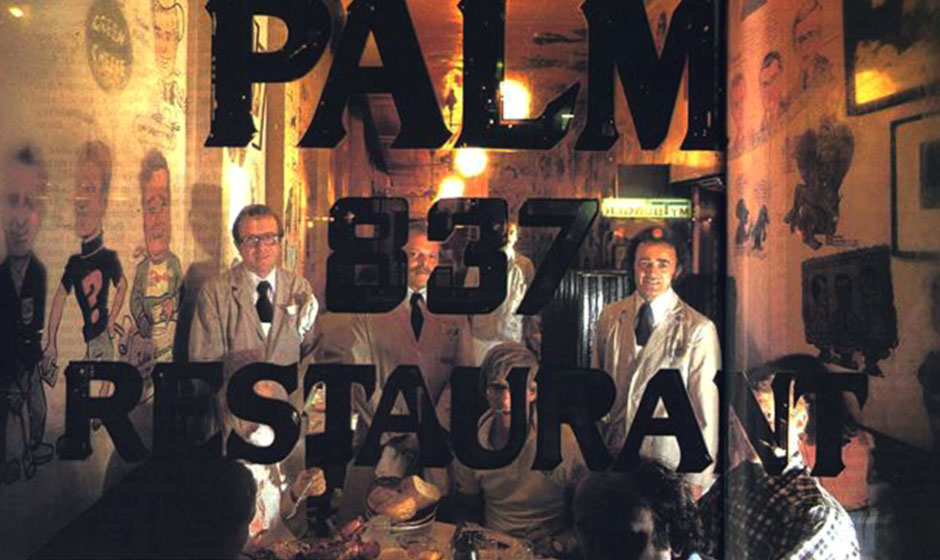
Sad
to relate, there aren't nearly as many great steaks
being served in NYC as there once were. I say this not
out of some addled nostalgia but because there are
just too many steakhouses and chefs chasing too little
USDA Prime beef, a grade that has been seriously
dumbed down over the past two decades. Many
people haven't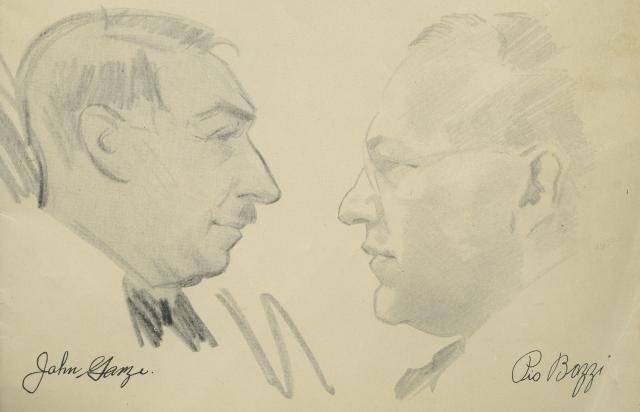 the foggiest
notion of what a great steak tastes like unless
they've gone to the last remaining bastions against
mediocre beef, and really the only places I can
guarantee a great steak in NYC I can count on the
fingers of one hand.
the foggiest
notion of what a great steak tastes like unless
they've gone to the last remaining bastions against
mediocre beef, and really the only places I can
guarantee a great steak in NYC I can count on the
fingers of one hand.
One of those fingers--the thumb
up--would be the original Palm on Second Avenue
between 44th and 45th Street. Not the one on the West
Side, not the one in Dallas or Boston or Philadelphia.
Just the original, whose beef is still nonpareil for
customers who would know otherwise just from the smell
of it. Indeed, the original owners, Pio Bozzi and John
Ganzi, immigrants from Parma, Italy, may have started
out as saloon keepers
during Prohibition, but little by little established
the model for
the New York Italian steakhouse that became a standard
in the industry in post-war
America.
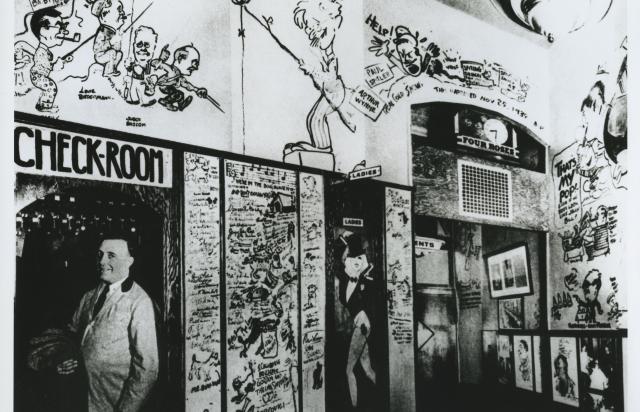 The
two men opened a saloon in 1926, on NYC’s east
side,
without serving food. But if customers asked for
something to eat, Ganzi ran to
a butcher shop to buy steaks then cook them. When Prohibition ended, Bozzi and
Ganzi sought to register
their place as a restaurant, but a NYC clerk who could
not understand their
accent issued the license under the name “Palm,” which
they retained.
(Regulars would never call
it "The" Palm.)
The
two men opened a saloon in 1926, on NYC’s east
side,
without serving food. But if customers asked for
something to eat, Ganzi ran to
a butcher shop to buy steaks then cook them. When Prohibition ended, Bozzi and
Ganzi sought to register
their place as a restaurant, but a NYC clerk who could
not understand their
accent issued the license under the name “Palm,” which
they retained.
(Regulars would never call
it "The" Palm.)
Palm
began serving a full menu of simple Italian dishes and
their steaks, personally
selected from prime carcasses in the Meat Market
District and adding items like
a tomato and onion salad, cottage fried potatoes,
lobsters, and for dessert,
cheesecake. It was a menu not dissimilar to that
served at other steakhouses in
the immediate vicinity—called “Steakhouse Row”--like
Christ Cella, Colombo’s,
and Bruno’s Pen & Pencil (all now closed), but
Palm became the best known,
not least for the murals of cartoon caricatures of
regular customers, a tradition
begun when local artists paid for their meals by
drawing the cartoons.
Later, some of NYC’s finest cartoonists
added their work to the walls.
For
decades Palm was very much a male enclave, including
many journalists from the
nearby newspapers, and not until the 1970s was it a
place where women would
feel comfortable dining without a man to bring them
there. In 1976 NY Times gave Palm its highest rating of
four stars.
After
Bozzi and Ganzi’s deaths, great grandson Bruce Bozzi
and son Walter Ganzi, Sr.,
took over the operation. Until the 1970s there was
only the original Palm
restaurant on Second Avenue at East 45th
Street and an adjunct
across the street.
In the 1980s,
however, the company began franchising, currently with
32 units in the U.S. and
abroad.
O.K.,
back to the steak.
The one-pound strip steak, or NY cut,
they
serve at Palm is the template for all others in
every steakhouse in America,
including the chain’s own. Palm’s corporation has
its own wholesale meat
company to supply its branches. The actual cooking
of the steak was mastered
long ago, though you’ll get something like the same
char elsewhere. Palm’s steaks aren’t glazed
with butter or black pepper
or garlic
or olive oil or
anything. They
are simply composed
of beef that tastes the way USDA Prime used
to taste in New York two to three decades ago and
now almost never does. The Palm strip steak,
which has a gamey, almost funky mineral taste
obtained from long, dry aging of
impeccably marbled beef of a quality that just
doesn’t find its way out of the
Second Avenue original’s lockers.
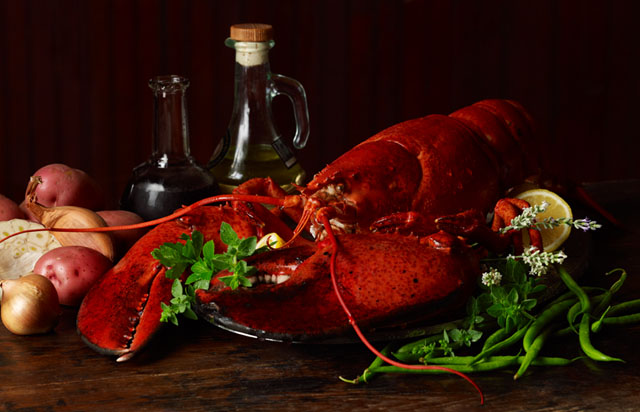 Just about everything else at Palm
has been perfected over the decades, and the menu
has changed little. You still want to order the
beefsteak tomatoes with crisp onions; the
bountiful poached shrimp cocktail; the huge
lobsters; the crisp cottage fries; the golden
onion rings and at meal's end the S&S
Cheesecake, which has no equal.
The winelist has gotten a whole lot better over
the years because of stiff competition, and the
drinks are still well made at the tiny bar.
Just about everything else at Palm
has been perfected over the decades, and the menu
has changed little. You still want to order the
beefsteak tomatoes with crisp onions; the
bountiful poached shrimp cocktail; the huge
lobsters; the crisp cottage fries; the golden
onion rings and at meal's end the S&S
Cheesecake, which has no equal.
The winelist has gotten a whole lot better over
the years because of stiff competition, and the
drinks are still well made at the tiny bar.
There may
well be pockets on the various floors considered
"A' tables, but you're not going to get better
beef or seafood at them. Frankly, I haven't been
to the branch right across the street, Palm II,
but I'd like to think it's just as good.
I’ve had
excellent strips at other New York steakhouses like Ben Benson’s (just closed),
Smith & Wollensky, Porter House, and Patroon, and
some
fine ones around the U.S. But none
is as identifiably delicious as the strip steak at
the Second Avenue Palm. There’s just not enough meat
of that
quality to go around, not even to the other Palm
units.
Go
just
once. You’ll
still go back to your
favorites elsewhere. But at the
original Palm--called Palm One--you’ll be tasting
something that can only be found in New York,
in a rigorously scruffy place where any idea of
change is met with a wag of the
head and the words, “You don’t get it, do you?”
❖❖❖
GALICIA
Wining and Dining in Northwest Spain
by
David Lincoln Ross
Photos by Bess Reynolds
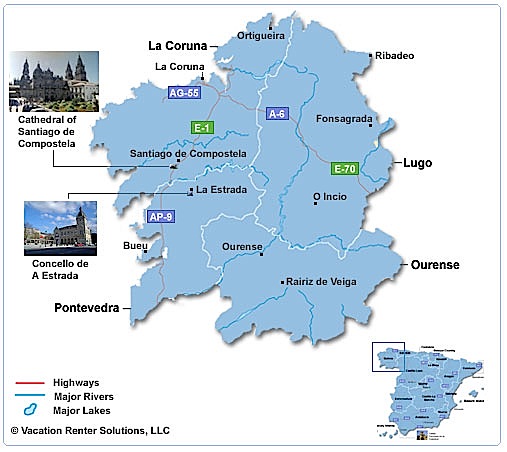 On
a cool, early May morning, Juan Gil de Araujo
González de Careaga (below) and your beret-topped
correspondent, walked under
his property’s 50-year-old Albariño vines, only
steps away from a downtown
plaza bearing the name of his family’s winery, Bodegas del Palacio de
Fefiñanes. The
winery’s home is the old port city of Cambados, which
is located in northwest
Spain, a region known as Galicia.
On
a cool, early May morning, Juan Gil de Araujo
González de Careaga (below) and your beret-topped
correspondent, walked under
his property’s 50-year-old Albariño vines, only
steps away from a downtown
plaza bearing the name of his family’s winery, Bodegas del Palacio de
Fefiñanes. The
winery’s home is the old port city of Cambados, which
is located in northwest
Spain, a region known as Galicia.
The country-in-city setting is
viticulturally
counter-intuitive: Who would expect to find a vineyard
smack in the middle of a
bustling business district? Yet, there, the vines
flourish behind a palace’s
high walls, thriving amid 12-plus acres of formal
gardens and thick forest
glades. Our host, the palace and vineyard’s owner, who
discreetly allows he is
a marquis, clearly treasures his family’s diminutive
but still productive
vineyard.
As proprietor, Juan, as he prefers
to be called,
is head of the family-owned company that markets a
line of well-respected white
wines, all grown and vinified in the Rias Baixas
(pronounced ree-ahs
bay-shus)
DO (Denominación de Origen). Juan also
proudly serves on the board of
trustees of the regional wine board of Rias Baixas,
which is comprised of both
privately owned labels as well as wines produced by
cooperatives encompassing
all five sub-regions of the DO appellation. In fact,
besides his ambassadorial,
administrative and marketing activities on behalf of
the DO, including spending
time with interested journalists and bloggers like
yours truly, Juan says he
sources most of his grapes for Fefinañes from
some 60 growers in Rias Baixas
DO, blending their grapes with those harvested from
his “palatial” vineyard.
These spicy, fragrant wines are the
veritable
fruit from one of Spain’s smallest, but most romantic
DOs. Windswept and green
like the western reaches of Ireland, Galicia and its
Rias Baixas wines have a
charm all their own. Perched along the Atlantic coast,
Galician
cooks features an immense array of exotic seafood and
shell-fish; yet,
further inland, chefs are also afforded the riches of
wild game as well as grass-fed
beef, goat and lamb. Pork, hugely popular here as in
the rest of Iberia, is
also served throughout Galicia, from tapas bars to
Michelin-starred
establishments. Galegos (as the citizens of Galicia
are called) thrive on
hearty, rustic dishes that rival any region in Spain,
or for that matter, those
of France (Gascony) or Italy’s (Puglia) most
celebrated cuisines.
As
the
guests of Juan, we feasted on fresh shellfish from
d’Berto, the renowned
seafood restaurant in O Grove in Galicia, Spain,
which is located near
Cambados; (from
left to right) crayfish, oysters, cockles,
scallops (two kinds: zamburiñas and volandeira ),
razor clams,
and Percebes
(upper right),
the latter extremely
rare and dangerous to harvest even by the most
skilled divers. With this meal,
we enjoyed the vintage 2011 from Juan’s winery; see
below for tasting notes.
On that overcast morning, Juan
welcomed my wife,
Bess Reynolds, and me at the winery and took us on a
brief tour of the
vineyards, gardens and modern winery housed in the
ancient stone palace. (Bess
is the talented photographer who captured these images
during our recent vinous
and culinary adventure across the Iberian peninsula.)
Then we enjoyed a splendid tasting of four of his
wines: two from the winery’s most recent vintages,
2011 and 2010; plus two
other innovative selections, relatively older
vintages given over to
aging on their lees.
Tasting Notes, Bodegas
del Palacio de Fefiñanes:
Vintage 2011,
Albariño de Fefinañes, 100 %
Albariño, 12.5% alc. – To the eye: Bright,
golden yellow hue; on the nose,
floral & citrus aromas; on the palate, crisp spice
and lemony flavors, with
good acid balancing its minerality and, on the finish,
not-quite-ripe white
peachy savors on the finish. Terrific with fresh
oysters, cooked seafood or as
an aperitif! Drink up now.
Vintage
2010, Albariño de Fefinañes, 100 % Albariño,
12.5% alc. – Slightly deeper
yellow, golden tints vs. 2011 vintage above; immense
floral, lemony nose;
bigger flavors of ripe honeydew and lemon on the
palate, and more spicy
complexity in the finish. An above-average vintage. Go
for oysters, and also
perfect with mild cheeses, goat and sheep’s milk; and
ideal with baked or
broiled fish, seafood stews and soups.  Delicious!
Drink now; good for 1-2 more
years.
Delicious!
Drink now; good for 1-2 more
years.
Vintage 2007,
Albariño de Fefinañes, III Año,
(“Third Year”), 100 % Albariño, 13% alc. – This
wine is aged a total of 30
months in stainless steel tanks, including an initial
six months on its lees.
Deep autumnal gold tints; some mild oak notes on nose
dominated by rich,
attractive floral aromas; lemon confit, cooked peaches
on palate with lingering
mineral flavors; complex, longer finish vs. 2010 and
2011 vintages above. Great
with sautéed sole, grilled monkfish, lobster;
also good with creamy cheeses or
even with a sweet flan for dessert! Drink now; will
mature 2-3 more years very
nicely.
1583,
Albariño de Fefinañes, 100 %
Albariño,
12% alc., vintage 2009 – This
wine, which pays homage to the family’s 16th century
builder of the Palacio,
who actually began construction in 1583, is a most
atypical Rias Baixas wine:
It is aged in a combination of French and American new
and formerly used oak
casks for five months. Deep golden tints; honeyed
fruit and wild rose floral
aromas; rich, zesty citrus and mineral flavors
intermingle; long finish with
cooked pear, white peach fruit. Great with cooked
shellfish, cod, swordfish,
tuna and baked or roasted poultry. Drink now; will
mature and evolve well for
3-5 years, more of a curiosity, as it is not a
traditional Rias Baixas wine,
but if you find it, it is eminently drinkable.
In
the U.S., at present, the 2010 vintage is in
wide distribution, and you should expect to pay about
$18-$22 per
bottle.
❖❖❖
BEFORE I ANSWER, WILL YOU BE SAUTÉEING,
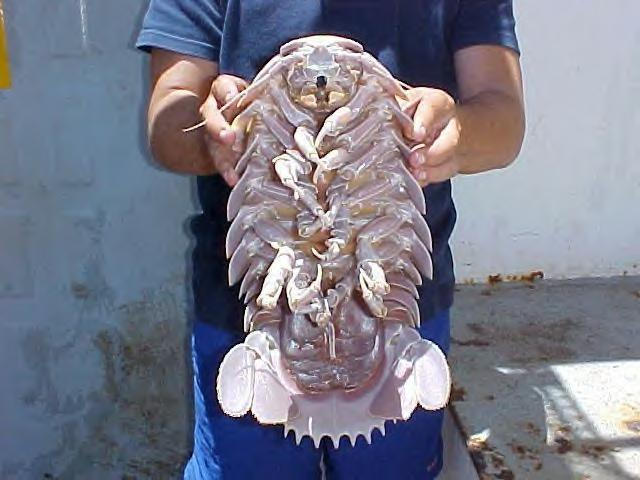 BROILING, OR STEAMING
THEM?
BROILING, OR STEAMING
THEM?"Dear
Mr. Gold: Do you have any ideas how we can procure
a large quantity of sand fleas? We need them very
soon for an upcoming culinary lecture.
Best
wishes,
Amy"
"Dear Amy: I have been asked where to
find the bony Bangladeshi fish
hilsa, Samoan pani keke, Uzbek spleen
sausage, and a Mongolian-style
of
sun-dried lamb, but this is possibly the best
query I have ever received. My late friend Seymour Benzer, a geneticist
long-associated with the Caltech fruitfly labs,
might have had a line on Talitridae,
but I have no idea whom to ask, or if anybody is
even doing research on them. I won't tell you to go
sunbathing at San Felipe, because I'm better than
that.
Best,
Jonathan," "Daily Dish,"
LA Times.

Howard
Stern told Grub Street he has sworn of meat:
"We recently became pescetarians, which means the
only protein we're getting is from seafood these
days. We just learned the word pesceterian."
Stern says that after recently rescuing a seagull,
he and his wife "felt really funny eating turkey and
chicken. We stopped that completely."
Any of John Mariani's
books below may be ordered from amazon.com.
 |
My latest book, which just won the prize for best book from International Gourmand, written with Jim Heimann and Steven Heller, Menu Design in America, 1850-1985 (Taschen Books), has just appeared, with nearly 1,000 beautiful, historic, hilarious, sometimes shocking menus dating back to before the Civil War and going through the Gilded Age, the Jazz Age, the Depression, the nightclub era of the 1930s and 1940s, the Space Age era, and the age when menus were a form of advertising in innovative explosions of color and modern design. The book is a chronicle of changing tastes and mores and says as much about America as about its food and drink.
“Luxuriating vicariously in the pleasures of this book. . . you can’t help but become hungry. . .for the food of course, but also for something more: the bygone days of our country’s splendidly rich and complex past. Epicureans of both good food and artful design will do well to make it their coffee table’s main course.”—Chip Kidd, Wall Street Journal.
“[The menus] reflect the amazing craftsmanship that many restaurants applied to their bills of fare, and suggest that today’s restaurateurs could learn a lot from their predecessors.”—Rebecca Marx, The Village Voice. |
"Eating Italian will never be the same after reading John Mariani's entertaining and savory gastronomical history of the cuisine of Italy and how it won over appetites worldwide. . . . This book is such a tasteful narrative that it will literally make you hungry for Italian food and arouse your appetite for gastronomical history."--Don Oldenburg, USA Today. "Italian
restaurants--some good, some glitzy--far
outnumber their French rivals. Many of
these establishments are zestfully described
in How Italian Food Conquered the World, an
entertaining and fact-filled chronicle by
food-and-wine correspondent John F.
Mariani."--Aram Bakshian Jr., Wall Street
Journal.
"Equal parts
history, sociology, gastronomy, and just
plain fun, How Italian Food Conquered the
World tells the captivating and delicious
story of the (let's face it) everybody's
favorite cuisine with clarity, verve and
more than one surprise."--Colman Andrews,
editorial director of The Daily
Meal.com. "A fantastic and fascinating
read, covering everything from the influence
of Venice's spice trade to the impact of
Italian immigrants in America and the
evolution of alta cucina. This book will
serve as a terrific resource to anyone
interested in the real story of Italian
food."--Mary Ann Esposito, host of PBS-TV's
Ciao
Italia. "John Mariani has written the
definitive history of how Italians won their
way into our hearts, minds, and
stomachs. It's a story of pleasure over
pomp and taste over technique."--Danny Meyer,
owner of NYC restaurants Union Square Cafe,
Gotham Bar & Grill, The Modern, and
Maialino.
|
 |
 |
 |
 |
 |
 |
 |
 |
 Everett Potter's Travel Report:
Everett Potter's Travel Report: 
 Eating Las Vegas
is the new on-line site for Virtual Gourmet
contributor John A. Curtas., who since 1995
has been commenting on the Las Vegas food
scene and reviewing restaurants for Nevada
Public Radio. He is also the
restaurant critic for KLAS TV, Channel 8 in
Las Vegas, and his past reviews can be
accessed at KNPR.org.
Click on the logo below to go directly to
his site.
Eating Las Vegas
is the new on-line site for Virtual Gourmet
contributor John A. Curtas., who since 1995
has been commenting on the Las Vegas food
scene and reviewing restaurants for Nevada
Public Radio. He is also the
restaurant critic for KLAS TV, Channel 8 in
Las Vegas, and his past reviews can be
accessed at KNPR.org.
Click on the logo below to go directly to
his site.

Tennis Resorts Online: A Critical Guide to the World's Best Tennis Resorts and Tennis Camps, published by ROGER COX, who has spent more than two decades writing about tennis travel, including a 17-year stretch for Tennis magazine. He has also written for Arthur Frommer's Budget Travel, New York Magazine, Travel & Leisure, Esquire, Money, USTA Magazine, Men's Journal, and The Robb Report. He has authored two books-The World's Best Tennis Vacations (Stephen Greene Press/Viking Penguin, 1990) and The Best Places to Stay in the Rockies (Houghton Mifflin, 1992 & 1994), and the Melbourne (Australia) chapter to the Wall Street Journal Business Guide to Cities of the Pacific Rim (Fodor's Travel Guides, 1991).


MARIANI'S VIRTUAL GOURMET
NEWSLETTER is published weekly. Editor/Publisher: John
Mariani.
Contributing Writers: Christopher Mariani, Robert Mariani,
John A. Curtas, Edward Brivio, Mort Hochstein,
Suzanne Wright, and Brian Freedman. Contributing
Photographers: Galina Stepanoff-Dargery,
Bobby Pirillo. Technical Advisor: Gerry McLoughlin.
© copyright John Mariani 2012
